- Home
- About Us
- Products
- Marble Statues Of Gods And Goddesses
- Marble Jain Moorties
- Marble Jesus Christ And Mary
- Marble Mandir and Temples
- Marble Vases
- Marble Plates
- Marble Pedestals And Plant Pots
- Marble Furniture
- Marble Animal Figures
- Marble Garden Items
- Marble Art Collections
- Marble Home & Kitchen Decors
- Jaipur Bangles
- Other Marble Statues, Sculptures & Busts
- Quality & Delivery
- Events
- Gau Sewa
- Contact Us
- Legend of Religious Idols
-
- Need Help?
- +91-9799820223
- moortiartsstatues@gmail.com
Browse Categories
- Marble Statues Of Gods And Goddesses
- Marble Jain Moorties
- Marble Jesus Christ And Mary
- Marble Mandir and Temples
- Marble Vases
- Marble Plates
- Marble Pedestals And Plant Pots
- Marble Furniture
- Marble Animal Figures
- Marble Garden Items
- Marble Art Collections
- Marble Home & Kitchen Decors
- Jaipur Bangles
- Other Marble Statues, Sculptures & Busts
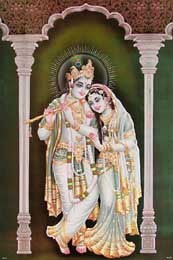
Radha Krishna are Hindu deity. Krishna is often referred as svayam bhagavan in Gaudiya Vaishnavism theology and Radha is a young woman, a gopi who is Krishna`s supreme beloved. In relation to Krishna, Radha is acknowledged as the Supreme Goddess, for it is said that she controls Krishna with Her love. It is believed that Krishna enchants the world, but Radha "enchants even Him. Therefore She is the supreme goddess of all."
Source of the test from:http://en.wikipedia.org/wiki/Radha_Krishna
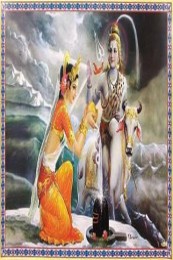
Lord Shiva is the representation of the Supreme Being and the third element in the Hindu Trinity. The other two members are Lord Brahma and Lord Vishnu. Lord Shiva is known as the creator, destroyer and preserver of the universe.
This cycle of destruction and recreation is always in a circle. Whenever evil tries to take prominence over good Lord Shiva dissolves the universe and starts all over again. Lord Shiva is known as the God of mercy and kindness. He protects his devotees from all evil that is always around us. He blesses his followers with grace, knowledge and peace. Here are the important symbols that depict Lord Shiva. Each of his depictions signifies a different aspect of his supreme being. The unclad body covered with ashes: this form of Lord Shiva depicts his otherworldly image. This image means that the complete universe gives forth from him. But lord Shiva’s presence is much higher than this physical phenomenon.
According to Hinduism, Shiva, the destroyer of evil and sorrow, resides at the summit of a legendary mountain named Kailasa, where he sits in a state of perpetual meditation along with his wife Parvati, the daughter of Himalaya. Kubera, the god of wealth was also said to have his abode on or near the mountain.
This Kailasa is regarded in many sects of Hinduism as paradise, the ultimate destination of souls and the spiritual center of the world.
Some traditions also aver that the mountain is Shiva`s linga and Lake Manasarowar below is the yoni of His consort. According to one description in the Vishnu Purana, Mount Kailash is the center of the world, its four faces are made of crystal, ruby, gold, and lapis lazuli. It is the pillar of the world; is 84,000 leagues high; is the center of the world mandala; and is located at the heart of six mountain ranges symbolizing a lotus. The four rivers flowing from Kailash then flow to the four quarters of the world and divide the world into four regions.
Source of the test from:http://en.wikipedia.org/wiki/Mount_Kailash
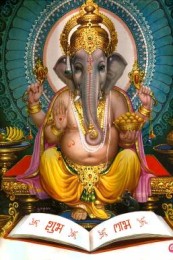
Ganesha, also spelled Ganesa or Ganesh and also known as Ganapati, Vinayaka, and Pillaiyar, is one of the best-known and most worshipped deities in the Hindu pantheon. His image is found throughout India. Hindu sects worship him regardless of other affiliations. Devotion to Ganesha is widely diffused and extends to Jains, Buddhists, and beyond India.
Although he is known by many other attributes, Ganesha`s elephant head makes him easy to identify. Ganesha is widely revered as the Remover of Obstacles and more generally as Lord of Beginnings and Lord of Obstacles (Vighnesha, Vighneshvara), patron of arts and sciences, and the deva of intellect and wisdom. He is honoured at the start of rituals and ceremonies and invoked as Patron of Letters during writing sessions.
Source of the test from:http://en.wikipedia.org/wiki/Ganesha
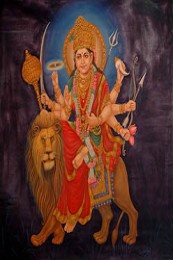
In Hinduism, Durga or Maa Durga (Mother Durga) is a form of Devi, the supreme goddess. Goddess Durga is considered by Hindus to be the mother of Ganesha, and Kartikeya. She is thus considered the fiercer, demon-fighting form of Shiva`s wife, goddess Parvati.
Durga is depicted as a warrior aspect of Devi Parvati with 10 arms who rides a lion or a tiger, carries weapons and assumes mudras, or symbolic hand gestures. This form of the Goddess is the embodiment of feminine and creative energy (Shakti).
The Great Goddess Durga is said to be exquisitely beautiful. Her form is blindingly bright (devi), with three lotus-like eyes, ten powerful hands, lush hair with beautiful curls, a red-golden glow from her skin and a quarter moon on her forehead. She wears a shiny oceanic blue attire emitting fierce rays. Her ornaments were carved beautifully of gold, with ocean pearls and precious stones embedded in it. Each god also gave her their own most powerful weapons: Rudra`s trident, Vishnu`s discus, Indra`s thunderbolt, Brahma`s kamandalu, Kuber`s Ratnahar, etc. Himalayas gifted her a fierce white and gold lion. On the end of the eighth and beginning of the ninth day of waxing moon, Chanda and Munda came to fight the goddess. She turned blue with anger and the goddess Chamunda leaped out of her third eye. Her form was the most powerful one with three red eyes, blood-filled tongue and dark skin; she finally killed the twin demons with her sword. This form of the divine goddess is worshiped during the sandhikshan of Durga Puja festival, as sandhi/chandi puja. Finally, on the tenth day of waxing moon, Durga killed Mahishasura with her trident.
The word Shakti, meaning sacred feminine force, and Durga reflects the warrior aspect of the goddess, embodying a traditional male role. She is also strikingly beautiful, and initially Mahishasura tries to marry her. Other incarnations include Annapurna and Karunamayi (karuna = kindness). Durga`s darker aspect Kali is represented as the consort of god Shiva, on whose body she is often seen standing.
According to the narrative from the Devi Mahatmya of the Markandeya Purana, the form of Durga was created as a warrior goddess to fight a demon. The demon`s father Rambha, king of the demons, once fell in love with a water buffalo, and Mahish Asur (the demon Mahish) was born out of this union. He is therefore able to change between human and buffalo form at will (mahish means "buffalo"). Through intense prayers to Brahma, Mahishasur had the boon that he could not be defeated by any man or god. He unleashed a reign of terror on earth, heaven and the nether worlds.
Eventually, since only a woman could kill him, the Holy Male Trinity went down to the river Ganges and prayed the mantra, "Om Namo Devaye", imploring of the great goddess Devi to save their realm from ruin. They were blessed with her compassion when the goddess Durga was born out of the river.
The four day long Durga Puja is the biggest annual festival in Bengal, Orissa and Bihar. It is celebrated likewise with much fervour in other parts of India, especially the Himalayan region, but is celebrated in various forms throughout the Hindu universe.
The day of Durga`s victory is celebrated as Vijaya Dashmi.
The actual period of the worship however may be on the preceding nine days (Navaratri) followed by the last day called Vijayadashami in North India or five days in Bengal (from the sixth to tenth day of the waxing-moon fortnight). Nine aspects of Durga known as Navadurga are meditated upon, one by one during the nine-day festival by devout Shakti worshippers.
In North India, the tenth day, signifying Rama`s victory in his battle against the demon Ravana, is celebrated as Dussehra - gigantic straw effigies of Ravana are burnt in designated open spaces (e.g. Delhi`s Ram Lila grounds), watched by thousands of families and little children.
In Gujarat it is celebrated as the last day of Navaratri, during which the Garba dance is performed to celebrate the vigorous victory of Mahishasura-mardini Durga.
The Goddess Durga is worshiped in her peaceful form as MahaGauri, The Fair Lady, Shree Shantadurga also known as santeri, is the patron Goddess of Goa. She is worshiped by all Goan Hindus irrespective of caste and even by some Christians in Goa.
Goddess Durga is worshiped in many temples of Dakshina Kannada district of Karnataka.
Source of the test from:http://en.wikipedia.org/wiki/Durga
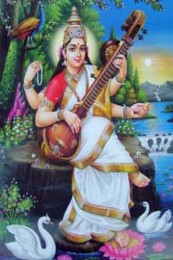
Saraswati is the Hindu goddess of knowledge, music and the arts. Saraswati has been identified with the Vedic Saraswati River. She is considered as consort of Brahma, the Hindu god of creation. Thus, with the goddesses Lakshmi and Parvati or Durga, she forms the Tridevi ("three goddesses"), who are consorts of the male trinity of Brahma, Vishnu and Shiva, respectively. Saraswati`s children are the Vedas, which are the oldest sacred texts of Hinduism.
Source of the test from:http://en.wikipedia.org/wiki/Saraswati
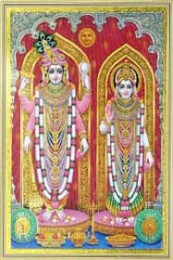
Vishnu is the supreme God in the Vaishnavite tradition of Hinduism. Smarta followers of Adi Shankara, among others, venerate Vishnu as one of the five primary forms of God, and his supreme status is declared in the Hindu sacred texts like Yajurveda, the Rigveda and the Bhagavad Gita.
Vishnu is described as having the divine colour of clouds (dark blue), four-armed, holding a lotus, mace, conch and chakra (wheel). Vishnu is also described in the Bhagavad Gita as having a `Universal Form` (Vishvarupa) which is beyond the ordinary limits of human sense perception. (Source: http://en.wikipedia.org/wiki/Vishnu)
Lakshmi or Mahalakshmi is the Hindu goddess of wealth and prosperity. Representations of Lakshmi (or Shri) are found also in Jain and Buddhist monuments, with the earliest archaeological representation found in Buddhist monuments.
Lakshmi in Sanskrit is derived from its elemental form "lakS," meaning to perceive or observe. This is synonymous with "lakSya," meaning aim or objective. Lakshmi is thus the goddess of the means to achieving objectives, including prosperity in the lives of mankind.
She is the consort of Vishnu and married Rama (in her incarnation as Sita) and Krishna (as Rukmini and Radha).
Source of the test from:http://en.wikipedia.org/wiki/Lakshmi
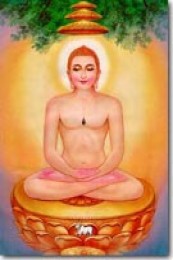
Mahavira, is the name most commonly used to refer to the Indian sage Vardhamana, who established what are today considered to be the central tenets of Jainism. According to Jain tradition, he was the 24th and the last Tirthankara. He is also known in texts as Vira or Viraprabhu, ...Sanmati, Ativira,and Gnatputra.
In a place called Kshatriyastan in the ancient kingdom of Lachuar in Jamui District (modern day South Bihar, India), Mahavira was born to King Siddartha and Queen Trishala on the 13th day under the rising moon of Chaitra (April 12 according to the Gregorian calendar). While still in his mother`s womb it is believed he brought wealth and prosperity to the entire kingdom, which is why he was also known as Vardhaman. An increase of all good things, like the abundant bloom of beautiful flowers, was noticed in the kingdom after his conception. Queen Trishala had 14 (16 in Digambara Sect) auspicious dreams before giving birth to Vardhaman, signs foretelling the advent of a great soul. Five km away from the 125 -year old Lachaur temple is Talhatti.After another gradual climb is `Ksatriyakund` atop another quiet , verdant hill. Vardhaman`s birthday is celebrated as Mahavir Jayanti, the most important religious holiday of Jains around the world. Mahavir Jayanti is celebrated with prayers, decorations, processions and festivity.
At the age of thirty Mahavira renounced his kingdom and family, gave up his worldly possessions, and spent twelve years as an ascetic. During these twelve years he spent most of his time meditating. His courage and braveness earned him the name Mahavira. These were the golden years of his spiritual journey, at the end of which he achieved Keval Gyan. He was now a person of infinite harmony, knowledge and self-control.
Mahavira devoted the rest of his life to preaching the eternal truth of spiritual freedom to people around India. He traveled barefoot and without clothes, in the hardest of climates, and people from all walks of life came to listen to his message. At one point Mahavira had over 400,000 followers. Mahavira`s preaching and efforts to spread Jain philosophy is considered the real catalyst to the spread of this ancient religion throughout India and into the mainstream.
At the age of 72 years and 4.5 months, he attained Nirvana (In Jainism, this is called as Moksh) in the area known as Pawapuri on the last day of the Indian and Jain calendars, Dipavali. Jains celebrate this as the day he attained liberation or Moksha.
Source of the test from:http://en.wikipedia.org/wiki/Mahavira
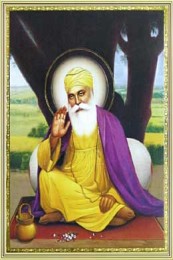
Guru Nanak (15 April 1469 - 7 May 1539) is the founder of Sikhism and the first of the ten Gurus of the Sikhs. He was born in the village of Talwandi, also called Rai Bhoe-ki Talwandi, now known as Nankana Sahib, near Lahore in present-day Pakistan. He was born, according to all ancient Sikh records, in the early morning of the third day of the light half of the month of Baisakh (April - May) in the year 1469 AD. Before Guru Nanak breathed his last in 1539, his name had travelled not only throughout India`s north, south, east and west but also far beyond into Arabia, Mesopotamia(Iraq), Ceylon, Afghanistan, Turkey, Burma and Tibet.
The name "Nanak" was used by all subsequent Gurus who wrote any sacred text in the Sikh holy scripture called the Guru Granth Sahib. So the second Sikh Guru, Guru Angad is also called the "Second Nanak" or "Nanak II". It is believed by the Sikhs that all subsequent Gurus carried the same message as that of Guru Nanak and so they have used the name "Nanak" in their holy text instead of their own name and hence are all referred to as the "Light of Nanak".
Source of the test from:http://www.sikhiwiki.org/index.php/Guru_Nanak
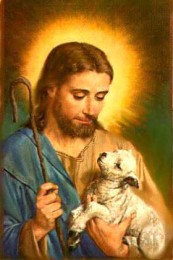
Jesus of Nazareth (7–2 BC/BCE—26–36 AD/CE), also known as Jesus Christ, is the central figure of Christianity and is revered by most Christian churches as the Son of God and the incarnation of God. Islam considers Jesus a prophet.
The principal sources of information regarding Jesus` life and teachings are the four canonical gospels though some scholars argue that other texts (such as the Gospel of Thomas) are as relevant as the canonical gospels to the historical Jesus. Most critical scholars in the fields of history and biblical studies believe that ancient texts on Jesus` life are at least partially accurate, agreeing that Jesus was a Galilean Jew who was regarded as a teacher and healer. They also generally accept that he was baptized by John the Baptist, and was crucified in Jerusalem on orders of the Roman Prefect of Judaea Pontius Pilate, on the charge of sedition against the Roman Empire. Aside from these few conclusions, academic studies remain inconclusive about the chronology, the central message of Jesus` preaching, his social class, cultural environment, and religious orientation.
Christian views of Jesus (see also Christology) centre on the belief that Jesus is divine, is the Messiah whose coming was prophesied in the Old Testament, and that he was resurrected after his crucifixion. Christians predominantly believe that Jesus is the "Son of God" (generally meaning that he is God the Son, the second person in the Trinity), who came to provide salvation and reconciliation with God by his death for their sins. Other Christian beliefs include Jesus` virgin birth, performance of miracles, ascension into Heaven, and future Second Coming. While the doctrine of the Trinity is widely accepted by Christians, a small minority instead hold various nontrinitarian beliefs concerning the divinity of Jesus.
Source of the test from:http://en.wikipedia.org/wiki/Jesus
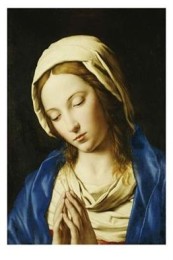
Mary (Maryam, later Hebrew Miriam, Greek Μαριαμ or Μαρια, in Arabic Maryam), called since medieval times Madonna (My Lady), was, according to Christian tradition, a Jewish resident of Nazareth in Galilee and known from the New Testament as the mother of Jesus of Nazareth. The New Testament describes her as a young maiden – traditionally, Greek parthénos signifies an actual virgin – who conceived by the agency of the Holy Spirit while she was already the betrothed wife of Joseph of the House of David and awaiting their imminent formal home-taking ceremony (i.e., the concluding Jewish wedding rite).
The name "Mary" comes from the Greek Μαρία, which is a shortened form of Μαριάμ. This is a transliteration of the Hebrew/Aramaic name Maryam. In later Hebrew the vowel "a" changed (regularly) to "i" in a closed unaccented syllable, so that by the time the Jews began to use vowel points, they wrote it as Miryam.
Source of the test from:http://en.wikipedia.org/wiki/Virgin_Mary
